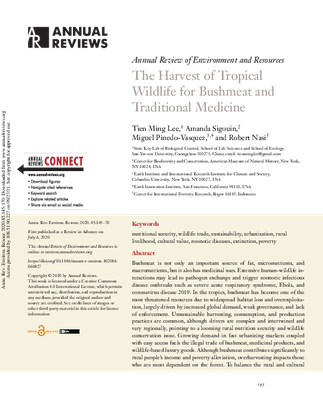The Harvest of Tropical Wildlife for Bushmeat and Traditional Medicine
Bushmeat is not only an important source of fat, micronutrients, and macronutrients, but it also has medicinal uses. Extensive human–wildlife interactions may lead to pathogen exchange and trigger zoonotic infectious disease outbreaks such as severe acute respiratory syndrome, Ebola, and coronavirus disease 2019. In the tropics, bushmeat has become one of the most threatened resources due to widespread habitat loss and overexploitation, largely driven by increased global demand, weak governance, and lack of enforcement. Unsustainable harvesting, consumption, and production practices are common, although drivers are complex and intertwined and vary regionally, pointing to a looming rural nutrition security and wildlife conservation issue. Growing demand in fast urbanizing markets coupled with easy access fuels the illegal trade of bushmeat, medicinal products, and wildlife-based luxury goods. Although bushmeat contributes significantly to rural people's income and poverty alleviation, overharvesting impacts those who are most dependent on the forest. To balance the rural and cultural importance of bushmeat with conservation and public health priorities, strategies to safeguard tropical biodiversity, sustainable harvest of wildlife with reduced health risk for nutrition and medicine are urgently needed.
https://biodiversitylinks.org/learning-evidence/wild-meat-collaborative-learning-group/evidence-collection/evidence-inbox/harvest-of-tropical-wildlife_wild-meat.pdf/view
https://biodiversitylinks.org/learning-evidence/wild-meat-collaborative-learning-group/evidence-collection/evidence-inbox/harvest-of-tropical-wildlife_wild-meat.pdf/@@download/image/image.png
File
The Harvest of Tropical Wildlife for Bushmeat and Traditional Medicine
Author(s):
Lee, Tien Ming
,
Sigouin, Amanda
,
Pinedo-Vasquez, Miguel
,
Nasi, Robert
Publication Date: 2020
Location: Global
DOWNLOAD FILE
Bushmeat is not only an important source of fat, micronutrients, and macronutrients, but it also has medicinal uses. Extensive human–wildlife interactions may lead to pathogen exchange and trigger zoonotic infectious disease outbreaks such as severe acute respiratory syndrome, Ebola, and coronavirus disease 2019. In the tropics, bushmeat has become one of the most threatened resources due to widespread habitat loss and overexploitation, largely driven by increased global demand, weak governance, and lack of enforcement. Unsustainable harvesting, consumption, and production practices are common, although drivers are complex and intertwined and vary regionally, pointing to a looming rural nutrition security and wildlife conservation issue. Growing demand in fast urbanizing markets coupled with easy access fuels the illegal trade of bushmeat, medicinal products, and wildlife-based luxury goods. Although bushmeat contributes significantly to rural people's income and poverty alleviation, overharvesting impacts those who are most dependent on the forest. To balance the rural and cultural importance of bushmeat with conservation and public health priorities, strategies to safeguard tropical biodiversity, sustainable harvest of wildlife with reduced health risk for nutrition and medicine are urgently needed.


